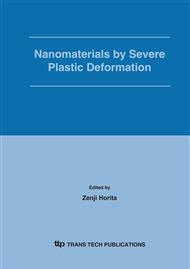[1]
V.M. Segal: Mater. Sci. Eng. A197 (1995), p.157.
Google Scholar
[2]
V.M. Segal: Mater. Sci. Eng. A271 (1999), p.322.
Google Scholar
[3]
R.Z. Valiev, R.K. Islamgaliev, I.V. Alexandrov: Prog. Mater. Sci. 45 (2000), p.103.
Google Scholar
[4]
V. M Segal, V.I. Reznikov, A.E. Drobyshevskiy, V.I. Kopylov: Russ Metall 1 (1981), p.99.
Google Scholar
[5]
M. Furukawa, Z. Horita, M. Nemoto, T.G. Langdon: J. Mater. Sci. 36 (2001), p.2835.
Google Scholar
[6]
Y. Iwanashi, M. Furukawa, Z. Horita, M. Nemoto, T.G. Langdon: Metall. Mater. Trans. 29A (1996), p.2245.
Google Scholar
[7]
Z.Y. Liu, G.X. Liang, E. D Wang, Z.R. Wang: Mater. Sci. Eng. A242 (1998), p.137.
Google Scholar
[8]
B. Mingler, H.P. Karnthaler, M. Zehetbauer, R.Z. Valiev: Mat. Sci. Eng. A319 (2001), p.242.
Google Scholar
[9]
C. Xu, M. Furukawa, Z. Horita, T.G. Langdon: J. of Alloys and Compounds 378 (2004), p.27.
Google Scholar
[10]
A. Vinogradov, T. Mimaki, S. Hashimoto and R. Valiev: Scripta Mat. 41 (1999), 319.
Google Scholar
[11]
H.S. Kim, S.I. Hong, M.H. Seo: Jour. Mater. Res. 16 (2001), p.856.
Google Scholar
[12]
S. Ferrasse, V. Segal, K.T. Hartwig, R. Goforth: Metall. Mater. Trans. 28A (1997), p.1047.
Google Scholar
[13]
M. Jane�ek, B. Hadzima, R.J. Hellmig, Y. Estrin: Metallic Materials (2005), in press.
Google Scholar
[14]
B. Hadzima, P. Pal�ek, M. Chalupová, R. �anády: Metallic Materials 41 (2003), p.257.
Google Scholar
[15]
F. Dalla Torre, R. Lapovok, P.F. Thomson, C.H.J. Davies, E.V. Pereloma: Acta Mater. 52 (2004), p.4819.
Google Scholar
[16]
D.A. Hughes, N. Hansen: Acta Mater. 48 (2000), p.2985.
Google Scholar
[17]
R.Z. Valiev, V. Y. Gerstman, O.A. Kaibyshev: Phys. Stat. Sol. A 97 (1986), p.11.
Google Scholar
[18]
R.Z. Valiev: Nanomaterials by severe plastic deformation, Proc. NanoSPD2 conf., ed. M.J. Zehetbauer, R.Z. Valiev, (Wiley-VCH, Weinheim, 2004), p.109.
DOI: 10.1002/3527602461
Google Scholar
[19]
R.J. Hellmig, S.C. Baik, J.R. Bowen, Y. Estrin, D.J. Jensen, H.S. Kim, M.H. Seo: ibid, p.257.
Google Scholar
[20]
F. King: Corrosion of copper in alkaline chloride environments, Tech. Report TR-02-25, SKB, Stockholm (2002).
Google Scholar
[21]
H.P. Leckie: J. Electrochem. Soc. 117 (1970), p.1478.
Google Scholar


